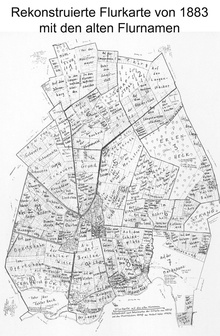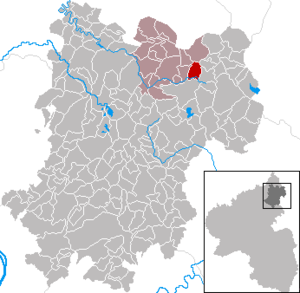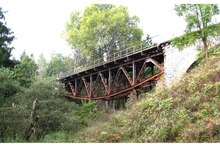Fehl-Ritzhausen
| coat of arms | Germany map | |
|---|---|---|

|
Coordinates: 50 ° 39 ′ N , 8 ° 0 ′ E |
|
| Basic data | ||
| State : | Rhineland-Palatinate | |
| County : | Westerwaldkreis | |
| Association municipality : | Bad Marienberg (Westerwald) | |
| Height : | 498 m above sea level NHN | |
| Area : | 4.02 km 2 | |
| Residents: | 766 (Dec. 31, 2019) | |
| Population density : | 191 inhabitants per km 2 | |
| Postal code : | 56472 | |
| Area code : | 02661 | |
| License plate : | WW | |
| Community key : | 07 1 43 222 | |
| Community structure: | 2 districts | |
| Association administration address: | Kirburger Strasse 4 56470 Bad Marienberg (Westerwald) |
|
| Website : | ||
| Local Mayor : | Volker clock | |
| Location of the local community in Fehl-Ritzhausen in the Westerwaldkreis | ||
Fehl-Ritzhausen (dialect: Feel-R'tshause ) is a municipality in the Westerwaldkreis in Rhineland-Palatinate . It belongs to the Bad Marienberg (Westerwald) community .
Geographical location
The community is located in the Westerwald between Limburg and Siegen . The Nister , which belongs to the catchment area of the Sieg , forms a large part of the boundary in the south.
Fehl-Ritzhausen includes the housing areas Fehler Hecke, Fehler Mühle and Tannenhof.
history
The current district of Fehl was first mentioned on January 6, 1307. At that time, Count Heinrich I of Nassau-Siegen and his wife Adelheid confirmed the existing income in Velde (= Fehl) and Graynsiven (= Großseifen ) to the abbot and convent of the Cistercian Abbey of Marienstatt . The first reference to Roitzhusen by name comes from October 27, 1340; In his will, the knight Eberhard Daube von Selbach bequeathed his widow Sophia a pension from the village tithe due to him .
The origins of both places possibly go back much earlier than the document mentions suggest. The name ending -hausen indicates a possible foundation in the 9th or 10th century. The preceding part of the name Ritz or Roitz is most likely derived from Rode - a name that was common from the 9th to the 12th centuries for settlements that arose on a cleared forest. Is even older perhaps incorrect . The name is derived from field, a designation that was particularly common in the 6th century for settlements that arose in open "fields" or on the bank of a body of water. In fact, the inhabitants of the mistake settled in the direction of the Nister , while to the north of them the people of Ritzhausen lived under the shelter of the Scheidchen mountain , which caught the north- westerly winds that brought snow.
Belonging to the parish Marienberg , in 1589 there were four houses in Fehl and eight in Ritzhausen with a total of around 50 people. By the end of the Thirty Years War , the population had dropped to 18. For the first time, Fehl and Ritzhausen were mentioned as a cohesive municipality in 1592. In 1732 they were named separately again, before an administrative reform within the county of Nassau-Beilstein brought another merger. The Handbook of Geography and Statistics of the Duchy of Nassau from 1823 speaks explicitly of Fehl and Ritzhausen as two villages , but characterizes them as a double municipality by summarizing their population under a common post ( 213 souls ).
The opening of the lignite mines in Höhn in 1746 and four years later in Stockhausen offered the Fehl-Ritzhäuser an alternative source of income. Your home village was connected to the postal network in 1775, so that from now on stagecoaches and messengers on horseback stopped in town. The electrification of the place in 1917 and - ten years earlier - the connection to the new Westerwaldquerbahn and the construction of a train station in 1906/1907 meant important civilizational progress . The branch line from Fehl-Ritzhausen to Bad Marienberg was shut down in 1971, and exactly ten years later came the end of the Westerburg– (Fehl-Ritzhausen) –Rennerod section. Since then, regular bus services have connected the town with the surrounding area.
Fehl-Ritzhausen was largely spared the destruction of the Second World War : at the end of 1944 and beginning of 1945, the site was targeted three times by Allied air raids, which primarily targeted the train station. The enemy bombs did little damage and claimed no lives among the 521 officially registered residents (as of 1939). All the more painful was the loss of the 38 men from Fehl-Ritzhausen who had died as soldiers in the Wehrmacht or who have been missing since then. Already in the First World War the place had paid a high blood toll with 22 dead, whereby long-established families like Neeb, Schell, Schürg, Stalp and Steup were repeatedly affected. Because the villagers drafted into the military were unable to work in agriculture, French and Russian or Soviet prisoners of war had to take over their duties in both world wars.
On March 27, 1945, the place was then taken by American troops without resistance.
coat of arms
Coat of arms history: Almost 700 years after the first documentary mention of the district of Fehl, the local community, the penultimate community within the Bad Marienberg community, has its own coat of arms. Evidence that a coat of arms was used by one of the districts has not yet been provided. On May 30, 1987, a design of the coat of arms was discussed in the municipal council for the first time and also considered usable, but was not approved by the state main archive in Koblenz. After a meeting in the main state archives on June 9, 1987, a new draft was presented in Koblenz on September 25, 1987, which was discussed in the local council on October 27, 1987 and approved unanimously. This draft submitted to the state main archives was approved on February 17, 1988 and thus the municipality was granted the approval document to use this coat of arms in future.
The graphic designer Lutz Golinske from Rheinbach - Wormersdorf made the draft based on an idea by Horst Schneider, who then also took on the further graphic design. Documents or records about the historical past of the two places are so far only a few known, apart from the more or less precisely kept school chronicle. The history of the current bell tower - although it was demolished by a few meters shortly before the old school was demolished in 1967 - the history of the procurement and the consecration of the current bells come from the local school chronicle. The wishes that Koblenz's district president Theo Zwanziger sent at the time for the approval of the coat of arms of the municipality of Fehl-Ritzhausen were: "That the fortunes of the municipality under this symbolism will always take a happy course for the benefit of the citizens".
| Blazon : "Divided by gold and blue by a wave bar divided by blue and silver, above a black bell tower, accompanied by two black bells, below a sixteen-bladed, silver mill wheel with two crossed, parallel double spokes." | |
|
Justification of the coat of arms: The upper and lower halves of the coat of arms indicate the formerly separate villages "Velle" for the first time around 1300 and "Roitzhusen" for the first time in 1340 in a document. The tower in the upper middle symbolizes the "Roitzhusen" chapel, built around 1400 and demolished around 1800. The two bells to the right and left of the tower are reminiscent of the two bells of this chapel, which have the inscriptions "0 'Rex Glorie veni cum pace" (0 'King of glory, come with peace) as well as "San Barab I call all evil Neither I verdriew I" had. The bell with the latter inscription was cast by a bell founder Tielmann in 1450. The first-mentioned smaller bell is said to have been much older and was probably cast by monks, because only they understood the art of bell-casting at that time. The smaller bell was melted down in World War I and the larger bell in World War II. The middle wave bar in blue and silver shows the nest , which forms the border south for both places, then and now.
The Nister separated Nassau-Dillenburg from its southern neighbor Nassau-Hadamar and became a denominational border in the course of the Counter-Reformation , because Nassau-Hadamar was recatholized from 1629/30, but Nassau-Dillenburg remained Calvinist . The water wheel is reminiscent of the Fehler Mühle , the buildings of which are still there, but have been closed since January 31, 1960. The colors gold and blue are the Nassau coat of arms colors; they indicate the former territorial affiliation of the places Fehl and Ritzhausen to Nassau. The colors yellow and blue are still used today by local clubs as club colors. |
Today's church bells
Since after the end of the Second World War the population wanted to get the community bells again, it was agreed to do this with donations from all citizens. The new bells were then cast on behalf of the community on October 21, 1949 at the Rincker bell foundry in Sinn near Herborn. The then mayor Otto Weber, some citizens of the community and the upper level of the Fehl-Ritzhausen elementary school were present at the casting. On November 13, 1949, the 284 kg and 162 kg bells were consecrated. The larger of the bells has an opening diameter of 785 mm and is tuned to the tone "C". It bears the inscription: “My name is peace, I guide people, I praise God's blessing. Allemol! Community of Fehl-Ritzhausen ”(No. Rinker 6700). The smaller bell has an opening diameter of 655 mm and is tuned to the tone "Es". It bears the inscription: “I greet mountains, valleys and forests, your homeland. Hui Wäller! Community of Fehl-Ritzhausen ”. (No. Rinker 6701). The total costs, including the necessary reconstruction of the bell cage, amounted to 3500 new German marks, of which 816 DM were donated directly by the citizens of the community, the rest came from the community treasury.
The consecration of the bells as peace and home bells at a small celebration was done by Pastor Schwedes from Marienberg. He spoke about the call of bells to heavenly home and heavenly peace. The consecration of the home bell was: Joh 9,4: “Work as long as it is day”; the consecration of the peace bell reads Col. 3,2: "Seek what is above". The first half-hour bell rang out to commemorate the dead and fallen of the war, who rest far from home in strange earth.

House and farm names
The rural tradition of house and farm names and their transfer to the residents was and is still widespread in Fehl-Ritzhausen, but is increasingly being forgotten. On the pictures house names in Ritzhausen and house names in Fehl , the house and family names from 1950, which are still in use today, are entered.
Old field names
Some of those listed in the stock books from 1854–1900 and on the old land maps are still used today.
politics
Municipal council
The council in Fehl-Ritzhausen consists of twelve council members, who in the local elections on May 26, 2019 in a majority vote were elected, and the honorary mayor as chairman.
mayor
In 2004, Volker Uhr became the mayor of Fehl-Ritzhausen. In the direct election on May 26, 2019, he was confirmed in his office for another five years with a share of the vote of 75.95%.
Culture and sights
traffic
- The B 414 runs north of the village and leads from Driedorf -Hohenroth to Hachenburg .
- The next motorway junction is Haiger / Burbach on the A 45 Dortmund - Hanau , about 22 kilometers away.
- The nearest train station is Westerburg station, 12 km away, on the Oberwesterwaldbahn from Limburg (Lahn) to Au (Sieg). The closest ICE stop is Montabaur train station on the Cologne – Rhein / Main high-speed line .
Web links
- Internet presence of the local community of Fehl-Ritzhausen
- The local community of Fehl-Ritzhausen on the website of the Bad Marienberg community
Individual evidence
- ↑ State Statistical Office of Rhineland-Palatinate - population status 2019, districts, communities, association communities ( help on this ).
- ^ Hermann Josef Hucke: Place names in the Westerwaldkreis in their dialect pronunciation as well as local nonsense. (PDF; 129 kB) (No longer available online.) 2010, p. 3 , archived from the original on January 9, 2014 ; accessed on October 19, 2019 .
- ↑ State Statistical Office Rhineland-Palatinate (ed.): Official directory of the municipalities and parts of the municipality. Status: January 2019 [ Version 2020 is available. ] . S. 72 (PDF; 3 MB).
- ↑ "Settlement Name Types II" (with explanations by Michael Gockel). Historical atlas of Hessen. In: Landesgeschichtliches Informationssystem Hessen (LAGIS).
- ↑ a b "700 years of Fehl-Ritzhausen"
- ^ The Regional Returning Officer Rhineland-Palatinate: Local elections 2019, city and municipal council elections. Retrieved October 19, 2019 .
- ^ Nadja Hoffmann-Heidrich: Election of the local mayor in the Bad Marienberg community on May 26th. Westerwälder Zeitung, February 27, 2019, accessed on June 2, 2020 .
- ^ The Regional Returning Officer of Rhineland-Palatinate: direct elections 2019. see Bad Marienberg, Verbandsgemeinde, fourth line of results. Retrieved June 2, 2020 .






